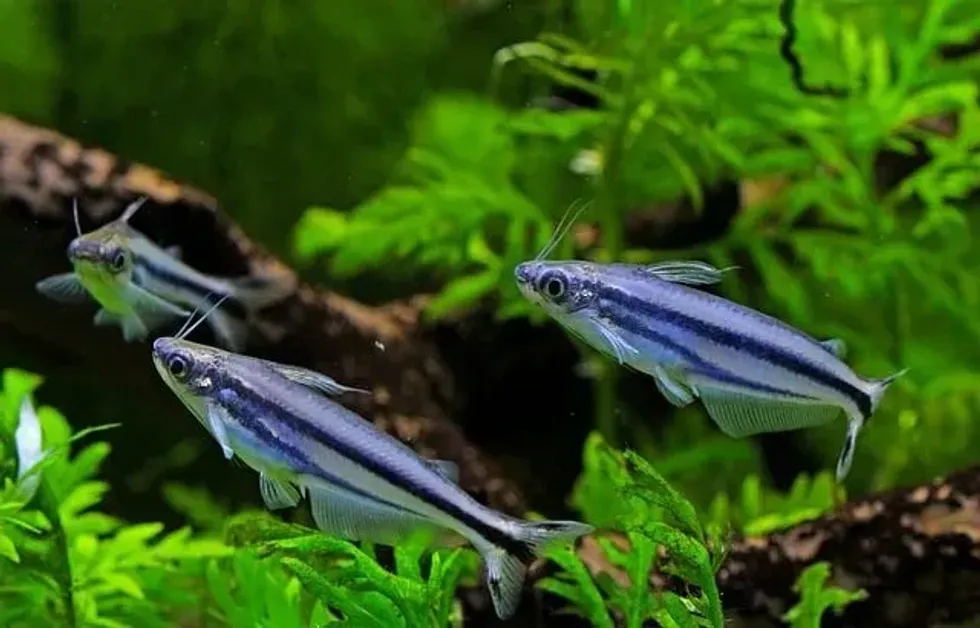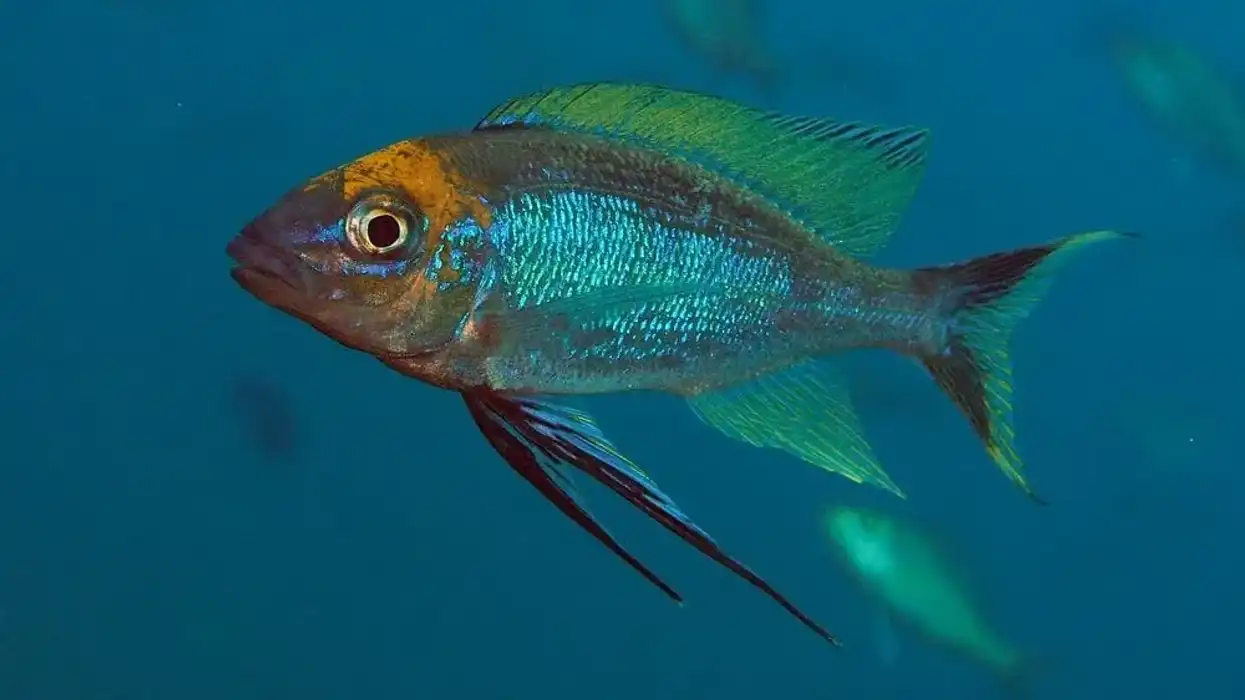There are 3000 species of catfish in the world. African glass catfish is one among the same family and is a relatively smaller catfish also known by two scientific names, Eutropiellus buffei and Pareutropius debauwi.
The African glass catfish is endemic to western Africa, the Central African Republic of Congo, and the Democratic Republic of Gabon. Catfish origin definition is referred to as freshwater fishes which have a stout body with long tactile barbels.
More than half of the catfish species are seen in the Americas, and their origin is freshwater regions. They are also kept in fish tanks as pets aside from freshwater regions.
As pets, it is preferable to keep such catfish in schools of six fishes or more. They can be kept along with other similar-sized fishes in a tank if you are considering adopting these fishes since they are low maintenance.
They prefer a planted aquarium as it is similar to their home environment. They are sold by their common trade name Debauwi catfish.
For more relatable content, check out channel catfish facts and anglerfish facts.
African Glass Catfish Interesting Facts
What type of animal is an African glass catfish?
African glass catfish is a type of fish that belongs to kingdom Animalia and the order Siluriformes.
What class of animal does an African glass catfish belong to?
The African glass catfish (Eutropiellus buffei) is a type of fish that belongs to the class Actinopterygii, family Schilbeidae, and genus Pareutropius.
How many African glass catfish are there in the world?
The exact population size of African glass catfish in the world is not known. These fishes are popularly seen in any swimming space, aquarium, or tank where they are kept along with floating plants and regulated water parameters. They are sold by their common trade name Debauwi catfish.
Where does an African glass catfish live?
African glass catfish live in freshwater bodies and in aquariums. African glass catfish live in regions including western Africa, the Central African Republic of Congo, and the Democratic Republic of Gabon. They are schooling fishes and kept together in tanks with six or more fish.
What is an African glass catfish's habitat?
An African glass catfish's habitat constitutes freshwater bodies as well as an aquarium or a tank. When they are kept as pets in tanks, the water needs to be an appropriate temperature, and they prefer living in a tank that resembles their natural habitat, including floating plants.
If kept in regulated water parameters, these fishes will be an amazing pet in your aquarium.
Who do African glass catfish live with?
African glass catfish live in their own schools and not alone, similar to three-striped African glass catfish (Pareutropius buffei). As pets, it is best to adopt them in schools of six or more. They can be spotted in an aquarium, tank, or freshwater body.
How long does an African glass catfish live?
African glass catfish live for seven to eight years. A Mekong giant catfish was around 170 years old and was is the oldest known catfish in the world.
How do they reproduce?
They don't usually breed in an aquarium however, in the wild in their natural habitat, male and female reproduction occurs through spawning. They can breed in a dedicated tank, however, young fry should not be left with the adults as they may pose a threat to the survival of the species.
Females lay close to 100 eggs per clutch and the eggs hatch approximately post 72 hours.
Once the fry has absorbed their yolk sacs, they are capable of feeding on tiny foods like dried shrimp and micro worms. Males and females may spawn multiple times throughout their life.
What is their conservation status?
African glass catfish are classified as a Least Concern species by the International Union For Conservation Of Nature IUCN Red List of Threatened Species.
African Glass Catfish Fun Facts
What do African glass catfish look like?
African glass catfish are an active fish and look similar to the three-striped African glass catfish (Pareutropius buffei). They have mostly clear to translucent bodies since they lack body pigmentation.
They have a total of 48-55 fin rays. The anal fin is large, clean, and crescent-shaped. They have streamlined bodies which help them facilitate locomotion.
They have two dark-colored eyes with a small mouth. Their length is estimated to be 4.7-5.9 in (12-15 cm), and when they are purchased, they usually come in a length of 2 in (5 cm).

How cute are they?
African glass catfish (Pareutropius debauwi) are similar to three-striped African glass catfish (Pareutropius buffei). This is a cute and exotic fish.
They require less space if you are considering keeping them as pets and they are wonderful pets. They are schooling fishes and need to be kept together instead of being kept alone in a tank, similar to three-striped African glass catfish (Pareutropius buffei).
How do they communicate?
African glass catfish communicate via signals. They also use electric pulses as signals. Some fishes release chemicals that can be sensed by smell or taste. Fishes are capable of hearing human voices. Over time, pet species are capable of recognizing their owners as well.
How big is an African glass catfish?
African glass catfish is 4.7-5.9 in (12-15 cm) in length, which is 10 times bigger than the smallest fish in the world, the dwarf minnow which is 1 in (2.5 cm). Keeping these two species of fish together is dangerous to the dwarf minnow.
How fast can an African glass catfish run?
They are small fish that have a relatively good swimming speed. They usually reside in schools and are seen in a group. They are territorial beings and may attack smaller fish.
How much does an African glass catfish weigh?
African glass catfish's exact weight is not evaluated. They are small-sized fish and weigh similar to three-striped African glass catfish (Pareutropius buffei). The largest fish in the world is the whale shark which weighs 40,000 lb (18,143 kg) and 480 in (1219.2 cm) long.
What are the male and female names of the species?
Males and females are not addressed differently. Females tend to be larger and have a slightly larger stomach in which they usually store the eggs, although they have a similar appearance. They also differ in reproductive functions.
What would you call a baby African glass catfish?
A baby African glass catfish is referred to as fry. Adults should be transferred into another tank post-spawning as they can pose a threat to the young fry. The parents are least involved in raising the young. Fry are active fishes.
What do they eat?
African glass catfish are primarily carnivorous fish, meaning they have a carnivorous diet. They use their mouth to feed on food. They feed on shrimp and smaller organisms floating in freshwater bodies.
They are also known to feed on smaller fish. In the case of young fry, once the fry has absorbed their yolk sacs, they are capable of feeding on tiny foods like dried shrimp and micro worms. Predators who consume them as food are bigger fishes.
Are they dangerous?
No, this peaceful freshwater fish poses no threat to humans. However, they do pose a threat to smaller fish so they cannot be placed with smaller fish. They are active fishes and can be shy.
Would they make a good pet?
Maintenance is simple with these aggressive yet fun transparent beings. They need to be fed timely and their diet consists of dried shrimp and other similar foods.
In the wild, they consume any food that suits their diet requirements. They should ideally be kept in groups and not alone in an aquarium or tank.
Keeping them in groups will help them live in an environment as close to their natural habitat, although they are in an aquarium or tank. These fishes are compatible with swordtails, danios, and black molly fishes.
They should be kept at an appropriate temperature to regulate their body temperature. An extreme temperature can impact their health. They are peaceful fishes and can be fed frozen foods. They are active beings and fun to keep as pets. They are sold by their common trade name, Debauwi catfish.
Did you know...
The habit of raising or breeding fish is called fishkeeping. Fishkeeping is a popular hobby kept by various people around the world. Breeding is done with the intention of keeping them as pets as well as in order for fish to be sold as food.
Fishes are, in various instances, frozen when they are sold as food. Frozen fishes lock in the vitamins and minerals in food and are one of the best alternatives to fresh fish. Frozen fishes are just as good nutritionally for you as fresh fish.
Are glass catfish aggressive?
African glass catfish live in groups and are sensitive to changes in water parameters, meaning regular maintenance is essential. They are similar to three-striped African glass catfish (Pareutropius buffei). They are nonaggressive beings and are peaceful.
This means they should be kept away from aggressive species of fish. They are resilient fish and these fish prefer dark places over being out in the open since they have a transparent appearance. Keeping this fish in groups is ideal in a tank with enough swimming space.
Can glass catfish live with a betta fish?
African catfish can live with betta fishes since they are relatively peaceful beings. Glass catfish are peaceful fishes, however, they should be kept in large tanks.
If you wish to add them to the same water tank, you could do so by placing plants, real or artificial, into the water.
In the same tank, betta fish can be distinguished by their stripes. The stripes on a betta fish run vertically along both sides of their body, while the African catfish betta is mostly transparent like or clear in appearance and are peaceful fishes.
Here at Kidadl, we have carefully created lots of interesting family-friendly animal facts for everyone to discover! For more relatable content, check out these coconut octopus facts and giant squid facts for kids.
You can even occupy yourself at home by coloring in one of our free printable African glass catfish coloring pages.









